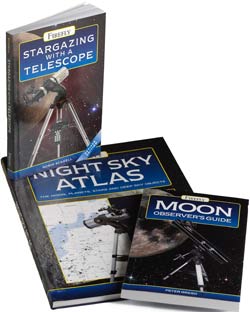Robin Scagell, 192 pages, Firefly Books, 2005; paperback, $14.95
Night Sky Atlas
Robin Scagell with maps by Wil Tirion, 128 pages, Firefly Books, 2005; paperback, $29.95
Moon Observer’s Guide
Peter Grego, 192 pages, Firefly Books, 2004; paperback, $14.95
Stargazing With A Telescope opens with a description of a star party — another great way for a beginner to be introduced to amateur astronomy! Stargazing includes a thorough discussion of binoculars, telescopes, and telescope mounts. How to choose and maintain a telescope are also discussed. Extensive descriptions of accessories, from eyepieces to filters, imaging, and computer software will help a beginning astronomer make choices as he or she advances in the hobby.
By the end of the next chapter, the new observer has a sense of how to navigate and find objects in the sky. Planispheres and star atlases are discussed, as well as nomenclature, constellations, and magnitudes. Only one chapter is devoted to what to observe, but the rather brief discussion includes objects ranging from within the solar system out to galaxies.
The Night Sky Atlas combines Scagell’s excellent writing skills with Wil Tirion’s famed sky charts. The opening chapter covers the sky, stars, and constellations and the basics of how the sky appears to move and change with the seasons. A discussion of equipment choices follows, from binoculars to telescopes and their performance, and mounts and how they work.
Scagell then advises the novice to start observing using the included seasonal star charts. Unfortunately these charts are so small and crowded that they’re not very useful.
Eight star maps cover the whole sky down to magnitude 5.5, which is useful only in rural skies. The left-hand page has black-stars-on-white charts with constellation stick figures. The right-hand page has a corresponding photo-realistic image, with stars’ colors depicted. Both run at 11 by 8 inches. This is a nice presentation, but I found faint stars are too prominent and the Milky Way is too weakly presented for the sky conditions assumed. Also, the layout is different from any star charts I have seen, and may confuse a beginner when he or she consults another atlas.
The next chapter concerns the Moon, beginning with observing information. Scagell describes the phases, and the text includes four quadrant maps with labeled features. Chapter 6 covers solar system observing and includes numerous photographs and sketches.
Stars and deep-sky objects are visited in the next chapter. Scagell begins with descriptions on a number of astronomical terms. She then dives into double and variable stars, star clusters, and various types of nebulae — each featured in a section of their own. Galaxies and observing them are near the end of the chapter, followed by observing tips such as how to find, draw, and photograph deep-sky objects.
Chapter 8 features 50 prominent constellations individually mapped, with interesting stars and deep-sky objects noted on the maps and discussed in the text. Variable stars have accompanying small charts with comparison stars. This chapter lacks a way to connect the individual constellation charts to their positions in the book’s star maps. Star-hopping is a great technique for finding stars and deep-sky objects, but you still need to know where to begin in the sky. This book is also missing a list of the Messier objects, the showcase objects of the northern two-thirds of the sky.
Peter Grego’s Moon Observer’s Guide focuses on the first celestial target beginners look at. It opens with a personal introduction and then gets right into lunar geology and features — a good, concise compendium that explains the recent science of lunar surface features and their origins.
The first chapter explains lunar basics: moonlight, phases, tides, and librations. It also covers the Moon illusion, wherein the Moon appears enormous while near the horizon and much smaller when high overhead. This isn’t the best explanation for this phenomenon I have seen, but I’m glad to see it covered.
Binoculars, telescopes, mounts, computers, and software are featured next. One can learn a lot from the thorough discussions here about selecting a telescope and eyepieces — useful for a beginner or a seasoned observer. The computer as an observing accessory allows one to keep some programs resident on the machine and to access other data available from the Internet via a list of bookmarks.
I especially enjoyed the almost-daily discussion of lunar features. Photographs and maps identify objects on the Moon’s surface where the solar illumination is at its best — when the Sun is low on the lunar horizon.
The closing chapters discuss how to record one’s observations, eclipses and occultations, and the Moon from the perspective of the Space Age. Readers will learn a lot about the Moon, and a lot about observing, from this book.
All three books are perfect bound (glued-back), which leaves them so tight that it is difficult to keep the books open for reading or use at the telescope. Push such a book open too far, and the book’s back will break, eventually leading to loose pages.
But I don’t want to close on a negative note. All of these books have a place on a beginner’s bookshelf, and both Stargazing With A Telescope and Moon Observer’s Guide offer skilled observers useful information. — Steve Edberg has observed for 40 years and teaches astronomy at La Cañada High School in La Cañada, California.
Daphne Burleson, 333 pages, McFarland & Company, 2005; hardcover, $75
Alice Calaprice, editor, 440 pages, Princeton University Press, 2005; paperback, $14.95












